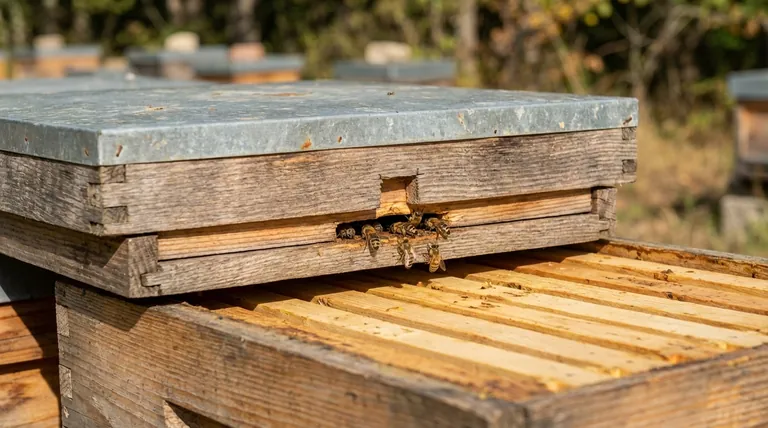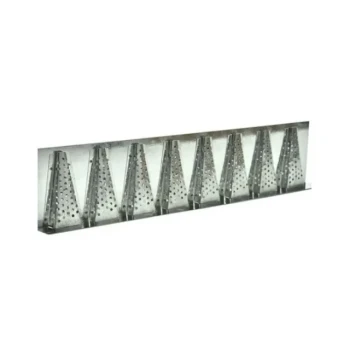To create an upper entrance, you simply slide the telescoping outer cover forward or backward in relation to the notched inner cover. When the outer cover is pulled away from the side with the notch, it exposes the opening, creating a functional entrance. Pushing the cover so it sits flush against the inner cover effectively closes this same entrance.
The adjustable upper entrance is more than just a secondary door; it is a critical tool for managing your hive's internal climate and workflow, primarily by controlling ventilation and reducing traffic congestion.

The Mechanics of the Upper Entrance
Understanding how the two primary hive covers work together is key to using this feature effectively. The design is simple but intentional.
The Notched Inner Cover
The inner cover sits directly on top of the uppermost hive box. It typically features a small, arch-shaped notch on one of its shorter sides. This notch is the fundamental component of the upper entrance system.
The Sliding Outer Cover
The outer cover, often a telescoping or migratory style, fits over the inner cover and the top of the hive body. It is designed with enough room to slide slightly forward and backward.
Opening and Closing the System
To open the entrance, you slide the outer cover away from the notched side of the inner cover, exposing the opening to the outside.
To close the entrance, you push the outer cover back until it is flush with the edge of the hive, completely covering the notch on the inner cover.
The Strategic Purpose of an Upper Entrance
This simple opening serves two distinct and important purposes depending on the season, directly impacting the health and productivity of the colony.
Critical Winter Ventilation
The most vital function of an upper entrance is to provide ventilation during winter. As the bee cluster consumes honey, they generate heat and release a significant amount of water vapor through respiration.
Without an escape route, this warm, moist air rises, hits the cold inner surface of the cover, and condenses. This condensation can drip back down onto the bees, chilling and potentially killing the cluster. An upper entrance allows this moist air to escape.
Reducing Summer Congestion
During a heavy nectar flow, the main bottom entrance can become a bottleneck. Foraging bees returning with nectar and pollen compete for space with bees leaving the hive.
An upper entrance provides a secondary exit and entry point, easing traffic congestion. This improves the colony's foraging efficiency, which can lead to a larger honey harvest. It also helps with air circulation on hot days.
Understanding the Trade-offs
While beneficial, an open upper entrance is not without its potential downsides. It's a tool that requires situational awareness.
The Risk of Heat Loss
For a small or weak colony, especially during colder months, an upper entrance can allow too much heat to escape. The colony must work harder to maintain the crucial temperature of the brood nest, consuming more resources.
A Potential Security Vulnerability
An upper entrance creates another access point that the colony must guard. This can be an entry point for robbing bees from other hives or pests like wasps, particularly if the colony is not strong enough to defend both entrances effectively.
When to Use the Upper Entrance
Your decision to open or close the entrance should be based on the colony's strength and your specific goals for the season.
- If your primary focus is winter survival: Keep a small upper entrance open to allow moisture to escape and prevent deadly condensation.
- If your primary focus is maximizing a honey harvest: Open the entrance during a strong nectar flow to reduce congestion and improve foraging efficiency.
- If your primary focus is protecting a weak or new colony: Keep the upper entrance closed to help them conserve heat and defend their hive more easily.
Properly managing this simple feature is a key indicator of proactive and thoughtful beekeeping.
Summary Table:
| Purpose | When to Use | Key Benefit |
|---|---|---|
| Winter Ventilation | Cold months to prevent condensation | Allows moisture to escape, preventing a damp, chilled hive |
| Summer Congestion | During a strong nectar flow | Reduces traffic jams, improving foraging efficiency and honey yield |
| Security & Heat Conservation | For new, weak, or vulnerable colonies | Helps conserve heat and makes the hive easier to defend |
Master your hive management with the right equipment from HONESTBEE.
We supply durable, precision-made beekeeping supplies and equipment to commercial apiaries and distributors. Our wholesale-focused operations ensure you get the reliable tools you need to expertly manage features like the upper entrance for healthier, more productive colonies.
Contact our team today to discuss your wholesale needs and elevate your beekeeping operation.
Visual Guide

Related Products
- Beehive Entrance Reducer Guardian Metal Hive Entrance for Bees
- Multi-Functional Rotary Hive Entrance Disc for Beekeeping
- Multi-Functional Sliding Hive Entrance for Beekeeping
- Steel Round Disc Entrance Reducer for Flexzion Bee Hive Nuc Box Gate
- Professional Hive Front Entrance Bee Feeder
People Also Ask
- What should be done after transferring frames to the new hive? Essential Steps for a Secure Colony
- What is the purpose of placing an object in front of the hive entrance after a move? A Guide to Forced Reorientation
- What are the different entrance sizes for an 8 or 10-frame Langstroth hive? A Guide to Seasonal Management
- What are the two functions of the Entrance Reducer? Master Hive Defense and Safe Transport
- How big should a beehive entrance be? Optimize for Colony Health & Honey Production



















